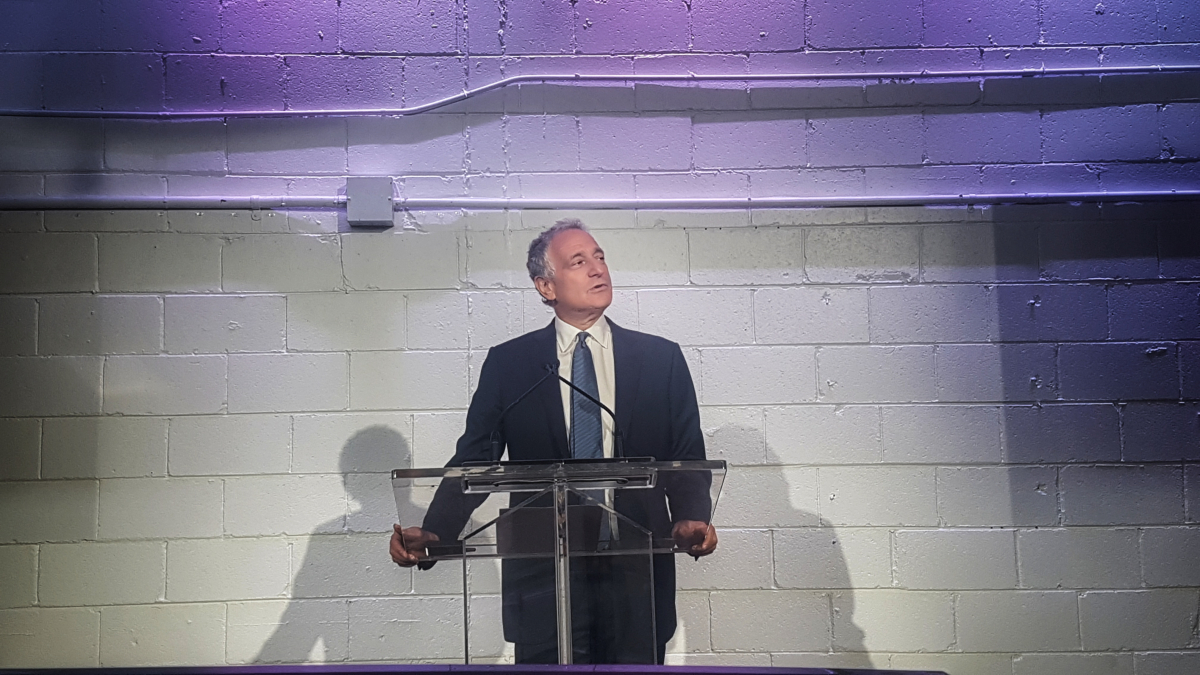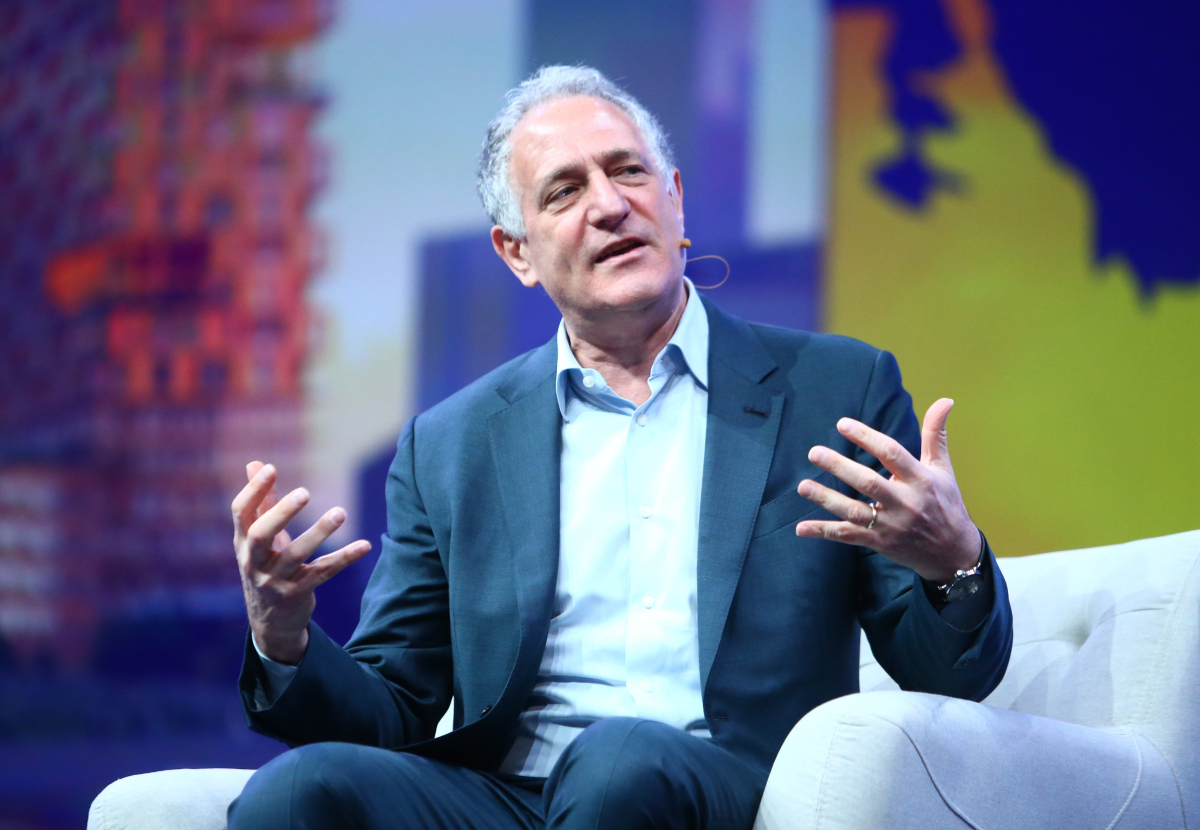Support strong Canadian climate journalism for 2025
In order to put the "largest, densest climate-positive district in North America" on Toronto's waterfront, Google's sister company plans to use all the cutting-edge clean-energy technology you'd expect. But the company's most innovative method to reduce greenhouse gases will come from a much humbler piece of tech: wood.
After 18-months of high-profile resignations, public pushback and extensive consultation, Sidewalk Labs revealed its master plan to build the world’s largest timber community by constructing 35-storey buildings with 100,000 cubic metres of wood— all of which will be manufactured in a $100-million sawmill it proposes to set up to help reduce construction timelines by as much as 35 per cent.
The technology giant is hoping to be the "lead developer" in turning Toronto’s eastern waterfront — an area that includes a 12-acre piece of land called Quayside and its neighbouring Villiers Island (earmarked for the new Google Canadian headquarters) — into a world-leading site of green innovation. The climate-oriented initiatives are part of a larger project to construct what is being billed as the world’s first smart city.

In its detailed plan, laid out in a 1,524-page "draft" proposal titled "Toronto Tomorrow: A New Approach for Inclusive Growth,” Sidewalk promises to source the timber sustainably from forest communities across Canada, but the number of trees required isn’t specified.
The sprawling development proposal is full of futuristic-sounding plans, including the creation of underground tunnels filled with autonomous carts that deliver packages, self-driving cars, extendable pedestrian walkways and sensor-operated heating and cooling systems. But at the heart is all-wood construction.
In recent years, many studies have noted building construction and operations contribute to more than a third of global emissions. According to a 2018 Senate report, residential, commercial and industrial buildings account for 17 per cent of Canada’s GHG emissions.Toronto’s buildings, too, have been found to account for roughly 60 per cent of the city’s emissions.
Employing timber is a way to reduce that significantly in the Toronto lakeshore community, according to Sidewalk Labs’s plan — because it helps speed up construction processes and the resulting buildings would absorb CO2 from the air, thereby serving as "carbon dioxide vaults." And, because Timber is naturally able to warm buildings, it’s well-suited to cold climates like Toronto’s.
"The 2.65 million square feet of built space in Quayside can forge a new paradigm. Quayside would be the first neighbourhood built entirely of mass timber, an emerging material as strong and fire-resistant as steel, but easier to manufacture and far more environmentally sustainable," Sidewalk Labs' master plan reads.
Sidewalk’s' experts told National Observer third-party certification organizations in the forestry sector will be employed as partners to ensure Indigenous communities are consulted and habitats are protected to avoid excessive runoff during the harvesting of trees, and the trees left behind are unharmed.
Canada is a leading supplier of certified forests that can be sustainably grown, and can also assist in tagging each sourced tree to ensure they are not mixed in the Toronto-based timber factory that is yet to be set up.
One of the company’s goals is to have a cheek-swab-like DNA test for each home in Quayside that will reveal what tree a certain panel of the wall came from and what date.

Officials said the organization is mindful that they will be employing a lot of trees and need to plant ahead of time to ensure there is no carbon deficit in the country. A lot of this will depend on how prepared Canada’s forestry supply chain is for this huge jump in demand for trees by the time construction begins (should the plan be approved).
One official expressed concern that Sidewalk Labs had the potential to absorb a big portion of Canada’s timber supply, making it difficult for any other industry that requires timber.
Sidewalk Labs could reduce Toronto’s GHG emissions
If all goes according to plan, Sidewalk Labs foresees the Quayside development reducing greenhouse gas emissions by 85 per cent (the IDEA district will reduce emissions by 89 per cent) and contributing 0.69 annual tonnes of clean energy per capita in 2028 by implementing the following initiatives:
Clean energy sources for heating and cooling: The plan envisions a “thermal grid,” which would provide heating, cooling and domestic hot water by drawing on clean sources such as geothermal (underground) energy and excess heat from buildings and waste water. The thermal grid could reduce greenhouse gas (GHG) emissions by 25.1 per cent from the city’s current average, and remove over 70,000 annual tonnes of carbon dioxide per person from areas outside the IDEA district
An advanced power grid that would use solar energy, battery storage and time-based energy pricing to reduce reliance on the main Toronto Hydro grid during periods of peak demand
Increased recycling with a smart disposal chain: A pneumatic tube system would separate waste streams underground, reducing contamination and centralizing the process of throwing and picking trash. An anaerobic digestion facility would help convert organic (food) waste into biogas for clean-energy use
An active stormwater management system that relies on green infrastructure to capture water before and during extreme weather. This could help reduce the flow of stormwater into municipal systems by 90 per cent
Electric vehicles, along with electric ride-hail services and charging incentives

The master plan states that in order to keep Quayside residents’ energy bills in line with Toronto averages, the advanced power and thermal grids would require a $19-million supplemental innovation investment to account for "the high cost of geothermal exchange and initial electric-grid connections, in addition to the poor economies of scale for operating costs."
Quayside's adjacent River District would provide a large enough area to support these investments, such as a new thermal-energy grid for heating and cooling buildings, the plan notes.
“If the innovations piloted in Quayside and Villiers Island are successful, governments could choose to apply them to a broader area, known as the Innovative Development and Economic Acceleration (IDEA) District,” across another roughly 190 acres of Toronto's Port Lands, the proposal says.
The proposal also finds that if the expansion to build the IDEA district was allowed, "it also becomes feasible to create a surplus of clean energy in the project area that could then be exported to buildings in other parts of the city, fulfilling Waterfront Toronto’s climate-positive vision by reducing the city’s overall emissions."
Plans for the 343-acre IDEA district were first revealed separately by National Observer and the Toronto Star in February. An internal presentation showed the technology giant was proposing a much larger-scale development project that would give the Alphabet subsidiary significant power to collect tax revenues and development fees for 16 per cent of the land along the lakeshore.
The company’s proposal shared with media and opened for public consultation Monday confirmed this expanded scope, but also noted this was merely an option, should the tripartite agency Waterfront Toronto, which includes representatives of all three levels of government, agree to their $1.4-billion investment in real estate and infrastructure. (At present, 78 per cent of the land in this proposed expansion is publicly owned.)

On Monday, more details were revealed about other aspects of the project, including its 18-month-long consultation process, its plans for light-rail transit connecting the lakeshore to the downtown core of the city and broad plans for "a government-sanctioned, independent data trust" that will address long-held privacy concerns surrounding the project.
The company has committed more than $50 million over the past 18 months to develop the draft master plan, speaking to “more than 21,000 Toronto residents.”
'We kept having to go back to the drawing board'
Sidewalk Labs' CEO, Dan Doctoroff, told reporters Monday that the climate crisis has been a priority for the organization's approach to Toronto's lakeshore development from its inception — with both public consultations and internal discussions focusing on how urban development can be innovated to address the world's biggest emergency.
Waterfront Toronto — the agency created by all three levels of government to oversee the redevelopment of Toronto’s shoreline — even outlined climate change as its focus in its requests for proposals for the revitalization of the city's lakeshore, saying it was "seeking a unique partner, one with invention ingrained in its culture, which can transform conventional business practices and help to establish a benchmark climate-positive approach that will lead the world in city building practices.”
On Monday, Doctoroff began his remarks to reporters by recalling that on March 3, when the firm was preparing to first unveil a series of prototypes on how to mitigate the effects of bad weather and create outdoor spaces that could remain comfortable and accessible for longer parts of the year, it was "snowing heavily" in Toronto. The extreme weather, he said, was proof urban development needed to be innovated to be ready for the climate crisis.

Toronto residents have "challenged us at every step and that made the plan better," Doctoroff said. It did, however, mean the plan took longer to formulate, he added. "We kept having to go back to the drawing board."
The proposal Sidewalk Labs presented Monday was "a novel but viable path" and "a blueprint for the neighbourhood of the future," Doctoroff said, that embraced technology in all aspects of city life.
"Our plan puts (the) public sector in the driving seat in a way that is not the norm for tech companies that deal with cities," he added. If Sidewalk Labs succeeds, it will create precedence for other tech companies to follow suit and work with governments in similar ways to help shorten commute times, make housing more affordable, create new standards for a healthier planet and do it with a model approach to managing data.
"We hope Toronto will be looked to around the world as the place that dared to take on the world's greatest urban challenges and point the way to a better future."
Doctoroff told reporters all aspects of the proposal will now be subject to public consultations, as well as “rigorous evaluation” by Waterfront Toronto.
“Any agreement to proceed to implementation of a final plan will require the approval of Waterfront Toronto and, in relevant parts, the three levels of government,” he said.






Comments
Um. “The resulting buildings would absorb CO2 from the air, thereby serving as "carbon dioxide vaults." Really? Timber (the material for these buildings) is dead trees. By what mechanism would they continue to absorb CO2?
Thanks to Fatima Sayed for this informative piece. I’ve been struggling to understand exactly what the developers are proposing. I’m also a little alarmed by their serene assumption that retractable coverings will protect inhabitants from such “extreme weather” as a snowfall. The history of retractable roofs in Canada is not a happy one; and if Sidewalk thinks a snowfall is extreme, they should perhaps spend a little time in Canada before they start building. Get to know the climate. Because they haven’t seen anything yet.
Most alarming of all though, is their idea that Sidewalk should share in tax revenue from the area. WHAT? Since when did we start electing developers? These are Americans, the folks who built a country on “no taxation without representation.” They should know better.
Please ... Fatima Sayed, more articles on this subject. Because I don’t think I’m the only one who doesn’t understand yet what’s going on here. What I do know is making me nervous.
This sounds like the same mentality that has gotten us to the current climate chaos, "bigger is better" non-sense. A lot of gobbledeegook in this piece. Where is all this mass timber to come from? BC? Our old growth forests are already being decimated at an alarming rate, how is this project conscionable? A tree plantation does not an old growth forest replace! How long before saplings start compensating for a 100 or 200 year old tree? if those saplings even survive forest fires & draughts. If this project was to be built with hem products I would applaud it. Go back to the drawing board Alphabet! you can do a lot better!
There are good elements in the plan - things we should have been implementing years ago - better stormwater, sewage and wast management systems - all delayed/ignored due to costs while we glorify sports with stadiums/arenas etc while our basic support systems for unban living crumble uner the weight of population growth and business-as-usual profit driven development.
Thermal energy is readily accessible by tapping into Lake Ontario's depths. Building codes have not even begun to adapt to the exigencies of climate disruption
No where in the report is there any mention of engineered structural wood that enables us to create the large dimensional timber needed for 35 storey structures. And, what kind of firefighting capability will be part of the planning - Prevention is the first imperative. I.E. upgrading electrical installation to eliminate the faulty materials and workmanship that promite hidden fires behind walls.